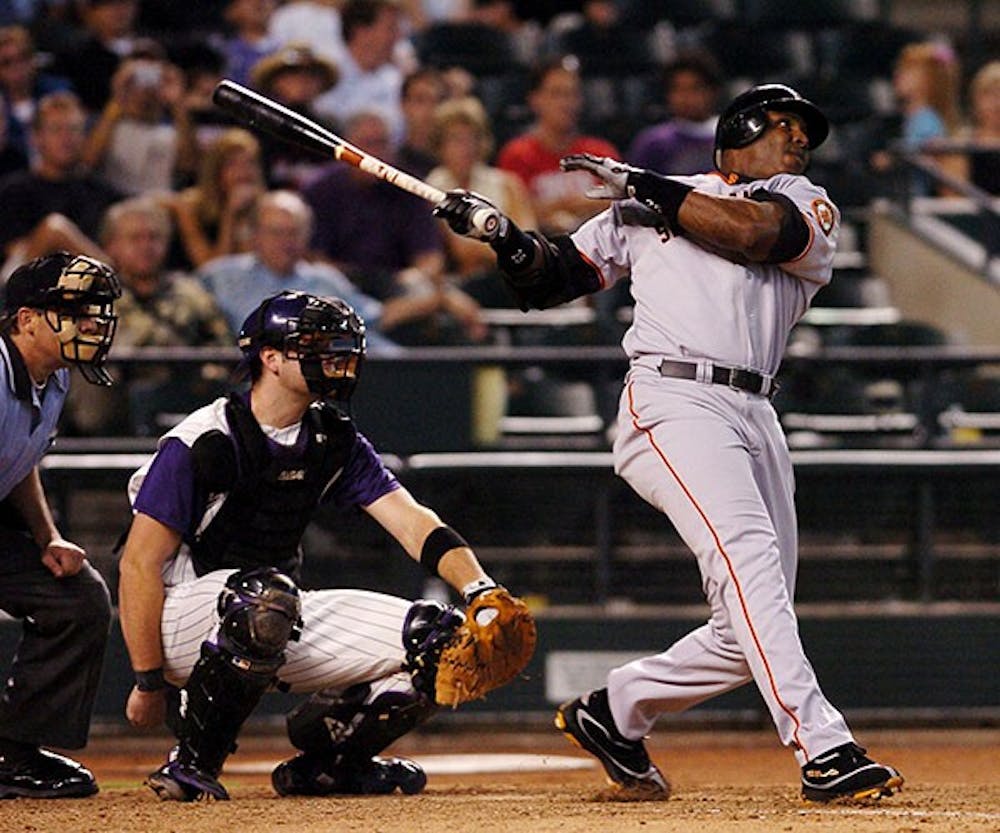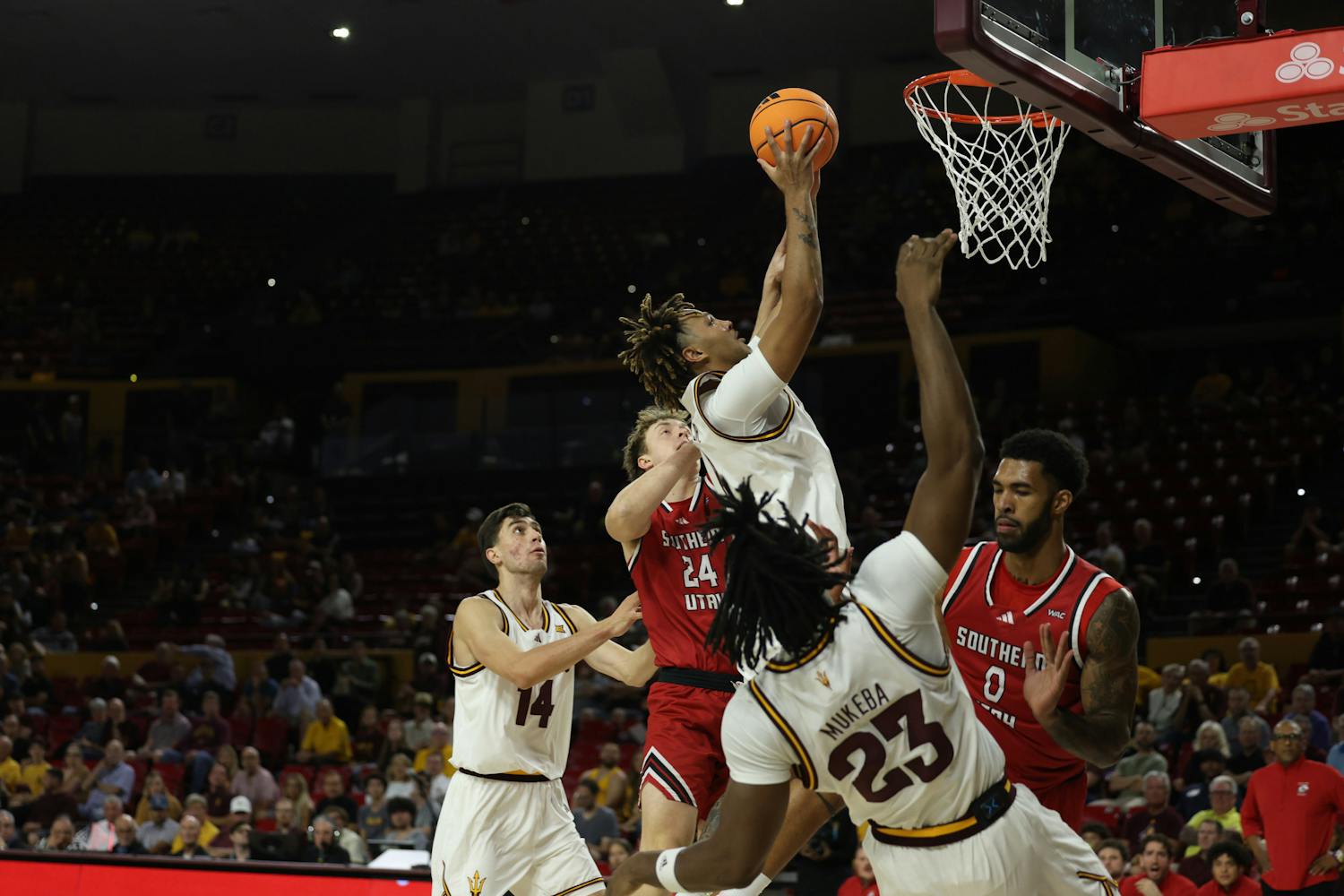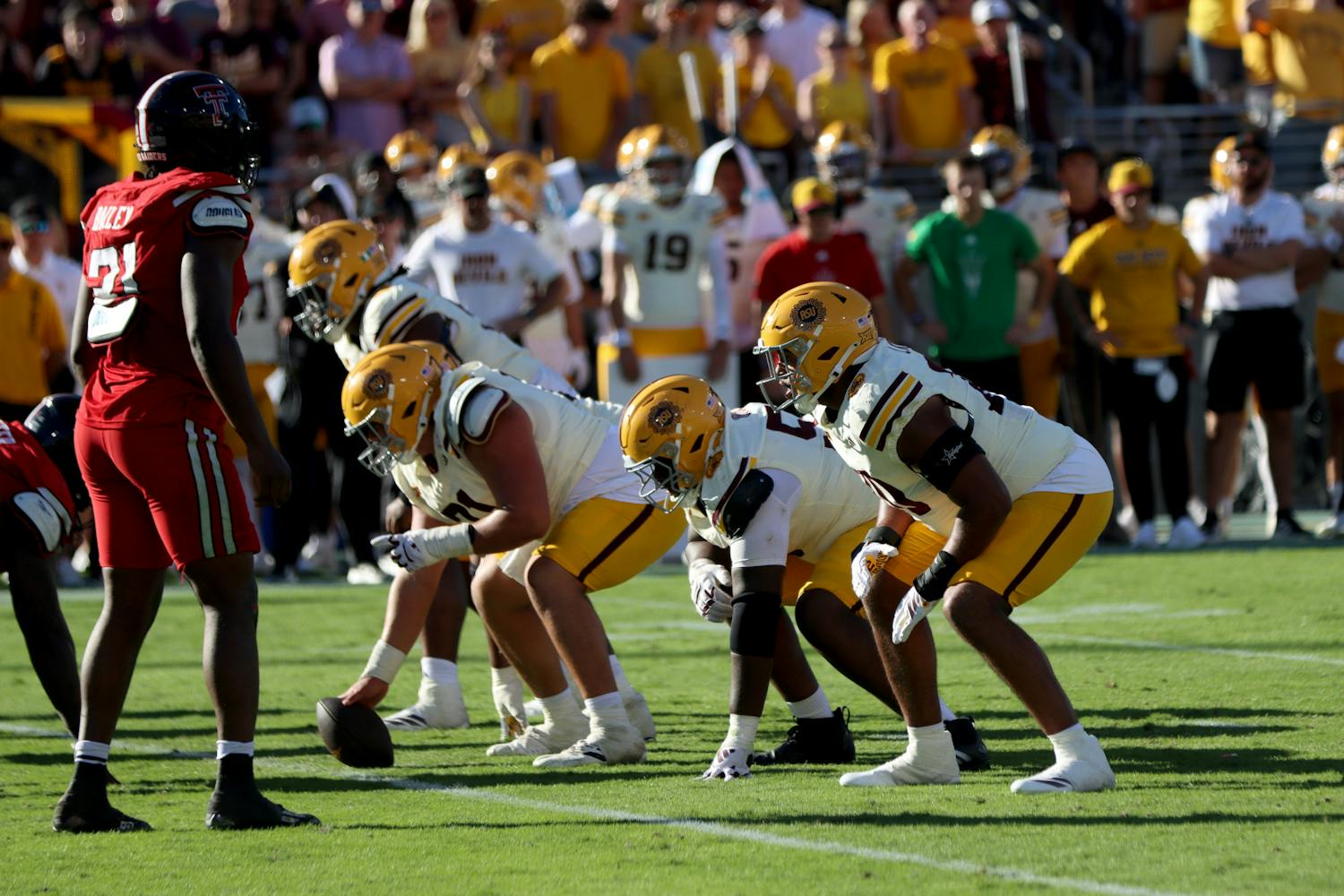 Los Angeles Angels outfielder and ASU alumnus Kole Calhoun stretches to catch a pickoff attempt during a home game in 2010 at Packard Stadium. (Photo by Scott Stuk)
Los Angeles Angels outfielder and ASU alumnus Kole Calhoun stretches to catch a pickoff attempt during a home game in 2010 at Packard Stadium. (Photo by Scott Stuk)In its illustrious 56-year history, the ASU baseball program has produced some of the best college and professional athletes ever to step foot on a diamond.
Among them are Andre Ethier, Barry Bonds, Dustin Pedroia, Reggie Jackson and Rick Monday.
ASU and the Pac-12 were recently lauded in an article by Baseball America, the goal of which was to find out which major NCAA Division I conferences laid claim to the most active talent on big-league rosters.
The Pac-12 was third, behind the SEC and ACC, with 42 active players on MLB teams.
ASU, however, is responsible for 11 of those 42, the most of any Division I team.
One of them is a versatile platoon player on a team widely regarded as the favorite to win the AL West for the third consecutive year.
Yet another is a journeyman whose experience in the Cactus League has strengthened his ties to the Valley, and he now finds himself right at home playing in the same organization.
Eric Sogard is a second baseman for the Oakland Athletics. But to his alma mater, he represents the sum of years of dedication to his craft, fine-tuned in fields around the country.
Drafted in the second round of the 2007 MLB Draft by the San Diego Padres, Sogard began in high-A ball, and over the course of three years, worked his way up the ranks of AA and AAA.
A trade to the A's gave Sogard a shot at the big leagues. After an impressive season for the Sacramento River Cats, he was promoted to Oakland and has shared time with veteran Nick Punto at second base.
Rising to fame in Spring Training because of Major League Baseball’s “Face of MLB” competition, Sogard began his path to the big leagues right here in the Valley.
The Thunderbird High School product earned numerous accolades during the first half of his amateur career, including being named the Arizona Republic’s NW Valley H.S. Baseball Player of the Year, Regional Player of the Year and First Team All-State shortstop.
For Sogard, it made sense to take his talents just a short drive away, in Tempe, to play for the then-No. 6 team in the country.
 San Francisco Giants slugger and ASU alumnus Barry Bonds connects on career home run number 699 in the ninth inning against Arizona Diamondbacks pitcher Mike Koplove. The Giants defeated the Diamondbacks, 5-2, at Bank One Ballpark (now Chase Field) in Phoenix, Ariz. on Sept. 12, 2004. (Photo Courtesy of Jose Carlos Fajardo/Contra Costa Times)
San Francisco Giants slugger and ASU alumnus Barry Bonds connects on career home run number 699 in the ninth inning against Arizona Diamondbacks pitcher Mike Koplove. The Giants defeated the Diamondbacks, 5-2, at Bank One Ballpark (now Chase Field) in Phoenix, Ariz. on Sept. 12, 2004. (Photo Courtesy of Jose Carlos Fajardo/Contra Costa Times)Sogard reflected fondly upon his time playing for ASU under the direction of then-head coach Pat Murphy, and then-assistant coach Tim Esmay.
“I had a lot of memories,” Sogard said. “I spent so much time there practicing and playing games. It’s really where I thought I had the chance to be a major league player, due to everything I learned from the coaches and the players. It was a special time for me, and I learned a lot and matured a lot through my life and baseball career.”
Sogard said that the mentorship of the ASU coaching staff enabled him to excel at the college level and beyond.
“Coach Murphy, he was a tough coach to play for,” Sogard said. “He really found a way to bring the best out of players. He made you mentally strong, and prepared us for anything. He prepared us for the next level, for pro ball. I learned so much while I was there, and I’m so grateful. He’s the most influential coach I’ve had throughout my career, without a doubt.”
If the retired numbers of Sun Devil legends on the outfield walls didn’t sell Sogard right away in his decision to play at ASU, they acted as a constant reminder of his goals and aspirations each time he set foot on the hallowed infield dirt of Packard Stadium.
“You look up on that board, and you see all those numbers and names up there, it’s amazing to think that all of those guys went to ASU,” Sogard said. “It shows you how elite ASU is as a baseball school, and how many major leaguers come out of there.
One of the most intriguing parts about being a Sun Devil in the big leagues is the fraternity that comes with playing for one of college baseball’s most storied programs, within the aptly titled “Conference of Champions,” the Pac-12.
Sogard and his Oakland teammates are an example of the chemistry that results from his team historically choosing to draft heavily from — and trade for — players within the Pac-12 Conference.
ASU’s rise to becoming a national powerhouse spurred the attention of pro scouts, already in town to watch Cactus League play, at the beginning of each season.
The proximity of the future Cactus League home of USC pitcher Tommy Milone, Stanford shortstop Jed Lowrie and fellow ASU alumnus infielder Jake Elmore — Phoenix Municipal Stadium — was beneficial when their teams would travel to play the Sun Devils at Packard. Often MLB executives and scouts would trickle out to watch college games to get a glimpse at the near future.
Sogard and his teammates often keep tabs on their respective alma maters during the collegiate postseason.
“Yeah, (during) the College World Series especially, if we’ve got our teams in it, we’re gonna be at these games, watching it together,” Sogard said. “ I think the Pac-12 sticks together, and we root for each other. If our team’s not in it, we’re gonna root for somebody in the Pac-12. Especially baseball wise, we all think it’s one of the most elite conferences in the nation. There are a lot of great players that come out of it and continue to be great.”
Sogard keeps in touch with his former ASU teammates and MLB colleagues Ike Davis, Andrew Romine and Mike Leake.
“(I do) especially if we’re playing during the season — we just got done playing (the Cleveland Indians and Jason Kipnis),” Sogard said. “I always talk to them before the game. Anytime we’re playing make sure to come out and say 'hi' and see how things are going. It’s great to have that during the year.”
Elmore took a slightly different road to professional baseball.
After two years in junior college at Wallace State Community College in Hanceville, Ala., Elmore began to attract the attention of USA TODAY’s preseason No. 1.
“I was in junior college in Alabama when they started recruiting me,” Elmore said. "And they were No. 1 in the country at the time. I think the main reason that I was there was because I knew how successful their program was and didn’t mind traveling away from home.”
Drafted by the Arizona Diamondbacks, Elmore spent time in the Houston Astros and Chicago White Sox organizations before landing in Oakland, where he has fit in well.
While Elmore and Sogard never donned ASU jerseys at the same time, the two both learned similar lessons from Murphy.
“One of the biggest things coach Murphy talked about was, you have to take accountability for yourself,” Elmore said. “If you’re not hitting well, it’s no coaches’ fault. It’s your responsibility. I’ve realized that when you struggle, it’s not because somebody messed up your swing, like some people say when the coach tries to help them.”
Murphy’s steadfast leadership helped Elmore overcome several obstacles on his way to earning a right to compete for a spot in spring training on one of baseball’s best teams.
“I’ve really dealt with some adversity at ASU a little bit, and obviously in the minor leagues, (and) it’s really tough,” Elmore said. “I just learned (from Murphy) to take accountability for my whole career.”
Elmore’s greatest experience playing for ASU came in one of Packard Stadium’s most attended games.
“In 2008, in the Super Regional, (we played) against Fresno State,” Elmore said. “It was packed; the berm was packed, (we were) under the lights. We beat Fresno State pretty handily (12-4).”
The Pac-12 brotherhood extended into Elmore’s circle as well, throughout his journey up the ladder of the minor league system.
“Every now and then, I’ll run across guys from UCLA and USC,” Elmore said. “It’s always kind of cool to see those guys and see that you were having fun in college playing against each other, and you’ve progressed and made it to a high level of baseball or play with them like Eric and I. It’s cool to have that bond.”
Elmore learned a key lesson early on in his professional career.
“It’s OK to have aspirations of playing professionally and playing in the big leagues, but one of the big things that college guys don’t realize that that’s the last time you play baseball for fun,” Elmore said. “Once you get to the minor leagues, it’s a job.”
Elmore advised that college baseball players take advantage of their time in school. Playing three or four years at the college level is much more common in baseball because prospects know they can hone their skills.
“Enjoy college life while they can, and if they are able to get drafted, to really focus on the season at hand,” Elmore said. “A lot of guys fall victim to saying ‘I want to get moved AA or AAA, or I want to get to the big leagues.’ Don’t worry about where you’re playing. As long as you have a jersey on your back, somebody’s watching, and that’s all that matters. Play not only for your team, but everybody watching.”
Reach the reporter at smodrich@asu.edu or follow him on Twitter @StefanJModrich




